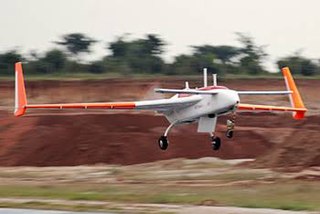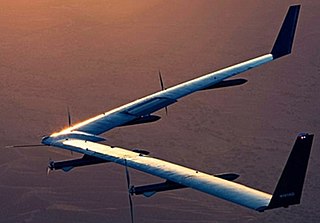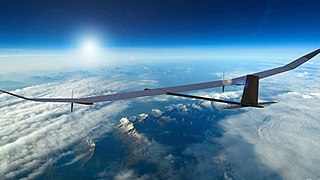Development
Zephyr 3
In 2003, QinetiQ, a commercial offshoot of the UK Ministry of Defence, was planning to fly its Zephyr 3 up to 40 km at 70 m/s (250 km/h; 140 kn), after being released from a high-altitude balloon at 9 km, besting the NASA Helios which had reached 29 km. [3] It was envisionned as an alternative to space satellites, stationed permanently in the stratosphere for environmental monitoring, mobile phone coverage or military applications. [3] The QinetiQ 1 balloon altitude record attempt failed in 2003. [4]
In February 2005, Qinetiq was preparing a demonstration above 30,000 ft for the UK Ministry of Defence at the Woomera Test Range in Australia, for reconnaissance or as a communications relay. [4]
Zephyr 6
Between 28 and 31 July 2008, in a demonstration for the US military at its Yuma Proving Ground in Arizona, the Zephyr 6 flew for 82 hours and 37 minutes, an unofficial record as the FAI wasn't involved. [5]
Zephyr 7
On 23 July 2010, the Zephyr 7 took the FAI-sanctioned duration record after a 336 hours (14 days), 22 min and 8 s flight, [6] reaching 21,562 m (70,741 ft). [7] It exceeded the nine days (216 hours) of the 1986 round-the-world flight of the Rutan Voyager. [8]
In March 2013, the project was sold to EADS Astrium (now Airbus Defence and Space). [9]
In 2014 it flew for 11 days in the short days of winter whilst carrying a small payload for the British Ministry of Defence, [10] and later near civilian airspace. [11]
Zephyr 8/S
In February 2016, the UK Ministry of Defence purchased two Zephyr 8 planes. [12] In August 2016, a third was purchased. [13]
In 2016, a twin-tailed Zephyr T variant, providing a maritime surveillance and communications capability, was scheduled for flight testing in 2018. [14]
In summer 2018, for its maiden flight from Arizona, the Zephyr S remained aloft for 25 days 23 hours 57 minutes, nearly twice as long as the previous record flight of 14 days set by its predecessor. [15] By October 2021, it had flown 2,435 hours. [16]
On 15 June 2022, the Zephyr S took off in Arizona, venturing for the first time into international airspace and over water. [17] On 19 August, the plane was lost over the Arizona desert after a flight time of 64 days. [18] It covered 56,000 km over the southern United States, the Gulf of Mexico, and South America. [19]
The aircraft was lost when one engine component (redesigned since) failed in an unusual high-altitude storm turbulence at 17 km. [2] By early 2023, Airbus planned to launch operations from the end of 2024 with around 18 aircraft. [2] By 2034, a 1,000 aircraft constellation could cover 2.9 billion people, and would provide emergency 4G/5G following natural disasters. [2] The larger Zephyr variant, with twice the payload capacity, is expected for 2026. [2]
Design
Zephyr 3
The 12 m (39 ft) wide aircraft had a carbon composite frame to weigh 12 kg (26 lb), and 1 kW of solar cells powering five motors. [3]
Zephyr 7
Zephyr 7 was larger, at 53 kg, [21] and capable of a maximum altitude between 20 and 21 km, [22] it required five ground crew to launch, as opposed to three previously for the Zephyr 6. [23]
Zephyr 8/S
Designed to fly at 20 km (65,000 ft) for more than a month, the 25 m (82 ft) wide Zephyr 8 is 30% lighter and can lift 50% more batteries than the Zephyr 7. [24] It weighs 60 kg, 40% of which are batteries (24kg), and the 5 kg payload can transmit video with a 50 cm resolution from above 20 km. [12] They should be able to operate year-round between 40 degrees North and South, while winter operation gets more difficult at higher latitudes. [12]
It used Amprius lithium-ion batteries with silicon nanowire anodes for a 435 Wh/kg specific energy up from 300–320 Wh/kg. [25] Solar cells are high-efficiency, lightweight, and flexible inverted metamorphic multi-junction epitaxial lift-off GaAs sheets manufactured by MicroLink Devices, with specific power exceeding 1,500 W/kg and areal powers greater than 350 W/m2. [26]
One Zephyr can replace 250 cell phone towers. [27] It can be used to perform intelligence, surveillance and reconnaissance (ISR) with a wide visual payload coverage of 20×30 km (12.4×18.6 mi) and can be equipped with radar, LIDAR and infrared technologies. [17]
Endurance is targeted for up to 200-300 days. [2] An 8 kg (17.6 lb) mobile connectivity payload can serve up to 100,000 people on the ground. [2] A 5 kg Airbus-developed Opaz optical sensor can deliver 18 cm-resolution imagery. [2]
QinetiQ is a multinational defence technology company headquartered in Farnborough, Hampshire. It operates primarily in the defence, security and critical national infrastructure markets and run testing and evaluation capabilities for air, land, sea and target systems.

The NASA Pathfinder and NASA Pathfinder Plus were the first two aircraft developed as part of an evolutionary series of solar- and fuel-cell-system-powered unmanned aerial vehicles. AeroVironment, Inc. developed the vehicles under NASA's Environmental Research Aircraft and Sensor Technology (ERAST) program. They were built to develop the technologies that would allow long-term, high-altitude aircraft to serve as atmospheric satellites, to perform atmospheric research tasks as well as serve as communications platforms. They were developed further into the NASA Centurion and NASA Helios aircraft.

The Scaled Composites Model 281 Proteus is a tandem-wing high-altitude long-endurance aircraft designed by Burt Rutan to investigate the use of aircraft as high-altitude telecommunications relays. The Proteus is a multi-mission vehicle able to carry various payloads on a ventral pylon. The Proteus has an extremely efficient design and can orbit a point at over 19,800 m for more than 18 hours. It is currently owned by Northrop Grumman.

A solar vehicle or solar electric vehicle is an electric vehicle powered completely or significantly by direct solar energy. Usually, photovoltaic (PV) cells contained in solar panels convert the sun's energy directly into electric energy.

AeroVironment, Inc. is an American defense contractor headquartered in Arlington, Virginia, that designs and manufactures unmanned aerial vehicles (UAVs). Paul B. MacCready Jr., a designer of human-powered aircraft, founded the company in 1971. The company is best known for its lightweight human-powered and solar-powered vehicles. The company is the US military's top supplier of small drones —notably the Raven, Switchblade, Wasp and Puma models.

Solar Impulse is a Swiss long-range experimental solar-powered aircraft project, and also the name of the project's two operational aircraft. The privately financed project is led by Swiss engineer and businessman André Borschberg and Swiss psychiatrist and balloonist Bertrand Piccard, who co-piloted Breitling Orbiter 3, the first balloon to circle the world non-stop. The Solar Impulse project's goals were to make the first circumnavigation of the Earth by a piloted fixed-wing aircraft using only solar power and to bring attention to clean technologies.

An electric aircraft is an aircraft powered by electricity. Electric aircraft are seen as a way to reduce the environmental effects of aviation, providing zero emissions and quieter flights. Electricity may be supplied by a variety of methods, the most common being batteries. Most have electric motors driving propellers or turbines.

The General Atomics Altus is an unmanned aerial vehicle, designed for scientific research, built by General Atomics Aeronautical Systems (GA-ASI).

The flight endurance record is the longest amount of time an aircraft of a particular category spent in flight without landing. It can be a solo event, or multiple people can take turns piloting the aircraft, as long as all pilots remain in the aircraft. The limit initially was the amount of fuel that could be stored for the flight, but aerial refueling extended that parameter. Due to safety concerns, the Fédération Aéronautique Internationale (FAI) no longer recognizes new records for the duration of crewed airplane or glider flights and has never recognized any duration records for helicopters.

The Solar Challenger was a solar-powered electric aircraft designed by Paul MacCready's AeroVironment. The aircraft was designed as an improvement on the Gossamer Penguin, which in turn was a solar-powered variant of the human-powered Gossamer Albatross. It was powered entirely by the photovoltaic cells on its wing and stabilizer, without even reserve batteries, and was the first such craft capable of long-distance flight. In 1981, it successfully completed a 163-mile (262 km) demonstration flight from France to England.

The DRDO Rustom is a medium-altitude long-endurance unmanned air vehicle (UAV) being developed by Defence Research and Development Organisation for the three services, Indian Army, Indian Navy and the Indian Air Force of the Indian Armed Forces. Rustom is derived from the NAL's LCRA developed by a team under the leadership of late Prof Rustom Damania in the 1980s. The UAV will have structural changes and a new engine.

A high-altitude platform station also known as atmospheric satellite is a long endurance, high altitude aircraft able to offer observation or communication services similarly to artificial satellites. Mostly unmanned aerial vehicles (UAVs), they remain aloft through atmospheric lift, either aerodynamic like airplanes, or aerostatic like airships or balloons. High-altitude long endurance (HALE) military drones can fly above 60,000 ft over 32 hours, while civil HAPS are radio stations at an altitude of 20 to 50 km above waypoints, for weeks.
The AeroVironment Global Observer is a concept for a high-altitude, long endurance unmanned aerial vehicle, designed by AeroVironment (AV) to operate as a stratospheric geosynchronous satellite system with regional coverage.

The NASA Centurion was the third aircraft developed as part of an evolutionary series of solar- and fuel-cell-system-powered unmanned aerial vehicles. AeroVironment, Inc. developed the vehicles under NASA's Environmental Research Aircraft and Sensor Technology (ERAST) program. They were built to develop the technologies that would allow long-term, high-altitude aircraft to serve as atmospheric satellites, to perform atmospheric research tasks as well as serve as communications platforms. It was developed from the NASA Pathfinder Plus aircraft and was developed into the NASA Helios.

AirStrato is a solar powered medium-sized unmanned aerial vehicle that was being developed by ARCAspace. There were two variants planned, AirStrato Explorer with a target flight ceiling of 18,000 m and AirStrato Pioneer with a target flight ceiling of 8000 m. It was planned to carry a 45 kg payload consisting of surveillance equipment, scientific instruments or additional battery pods for extended autonomy. The first prototype maiden flight took place on February 28, 2014. It was equipped with a fixed landing gear. Two more prototypes were constructed that lacked a landing gear. Instead ARCA opted for a pneumatic catapult as a launcher and landing skids and a recovery parachute for landing. Both prototypes performed take-off and landing testing and low altitude flights.

The Facebook Aquila is an experimental solar-powered drone developed by Facebook for use as an atmospheric satellite, intended to act as relay stations for providing internet access to remote areas. The Aquila first flew on 28 June 2016 with a second aircraft successfully flying in 2017. Internal development of the Aquila aircraft was stopped in June 2018.
The Odysseus is a solar, High-Altitude Long Endurance drone developed by Aurora Flight Sciences.
HAPSMobile is a wholly-owned subsidiary of SoftBank planning to operate High Altitude Platform Station (HAPS) networks. HAPSMobile is developing the Hawk30 solar-powered unmanned aircraft for stratospheric telecommunications. It has a strategic relationship with Loon LLC, a subsidiary of Google's parent Alphabet Inc.

The BAE Systems Persistent High Altitude Solar Aircraft (PHASA-35) is a High-Altitude Long Endurance (HALE) unmanned aerial vehicle (UAV) developed by BAE Systems in collaboration with Prismatic. Designed as a cheaper alternative to satellites, the aircraft can be used for surveillance, border control, communications and disaster relief with a potential ability to stay airborne for up to 12 months. Developed in less than two years, the aircraft carried out its first flight in February 2020 and further trials are currently ongoing.

The Vanilla UAV is a long-endurance, low-cost UAV produced by American manufacturer Vanilla Unmanned. It has flown unrefueled over 8-days.
















